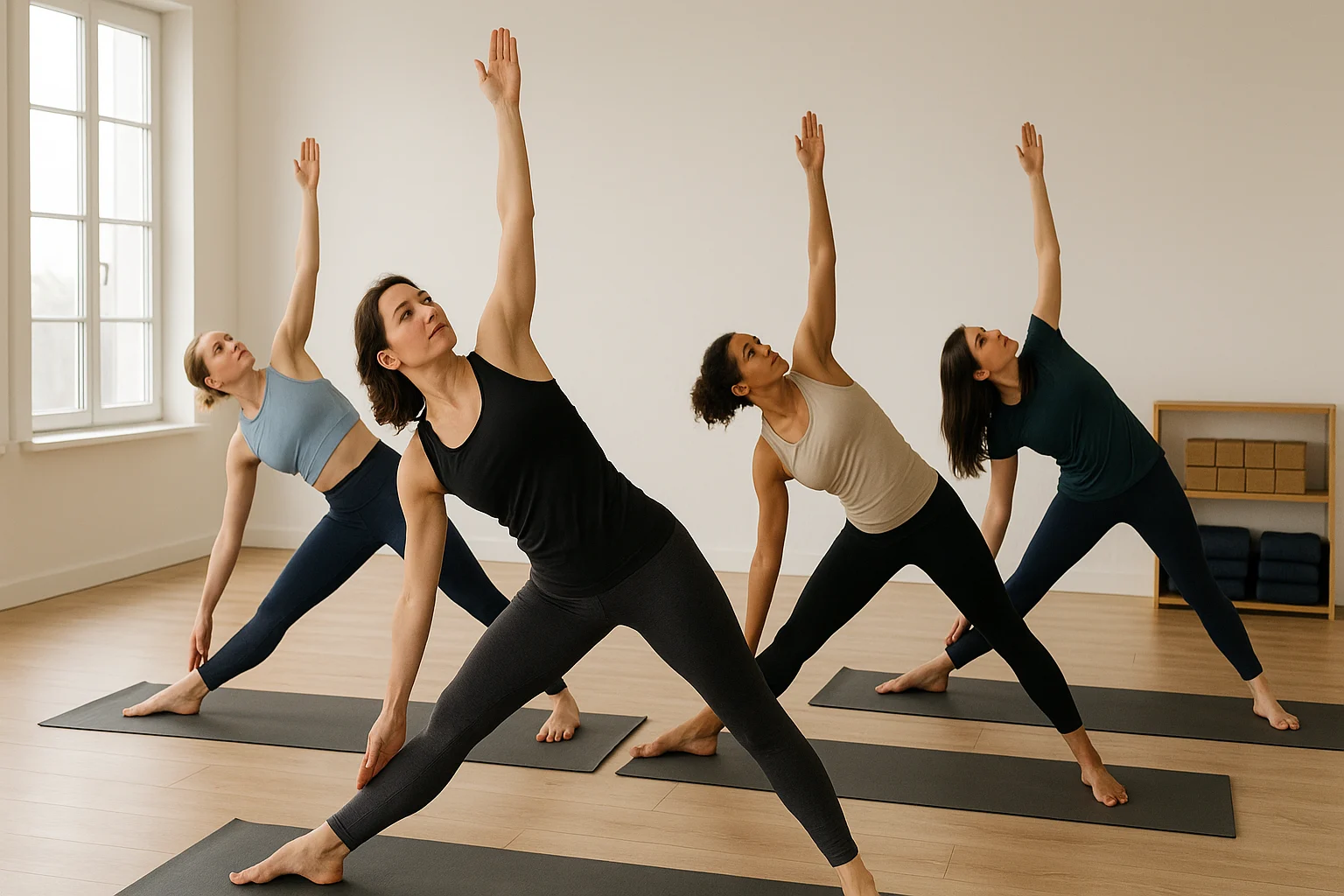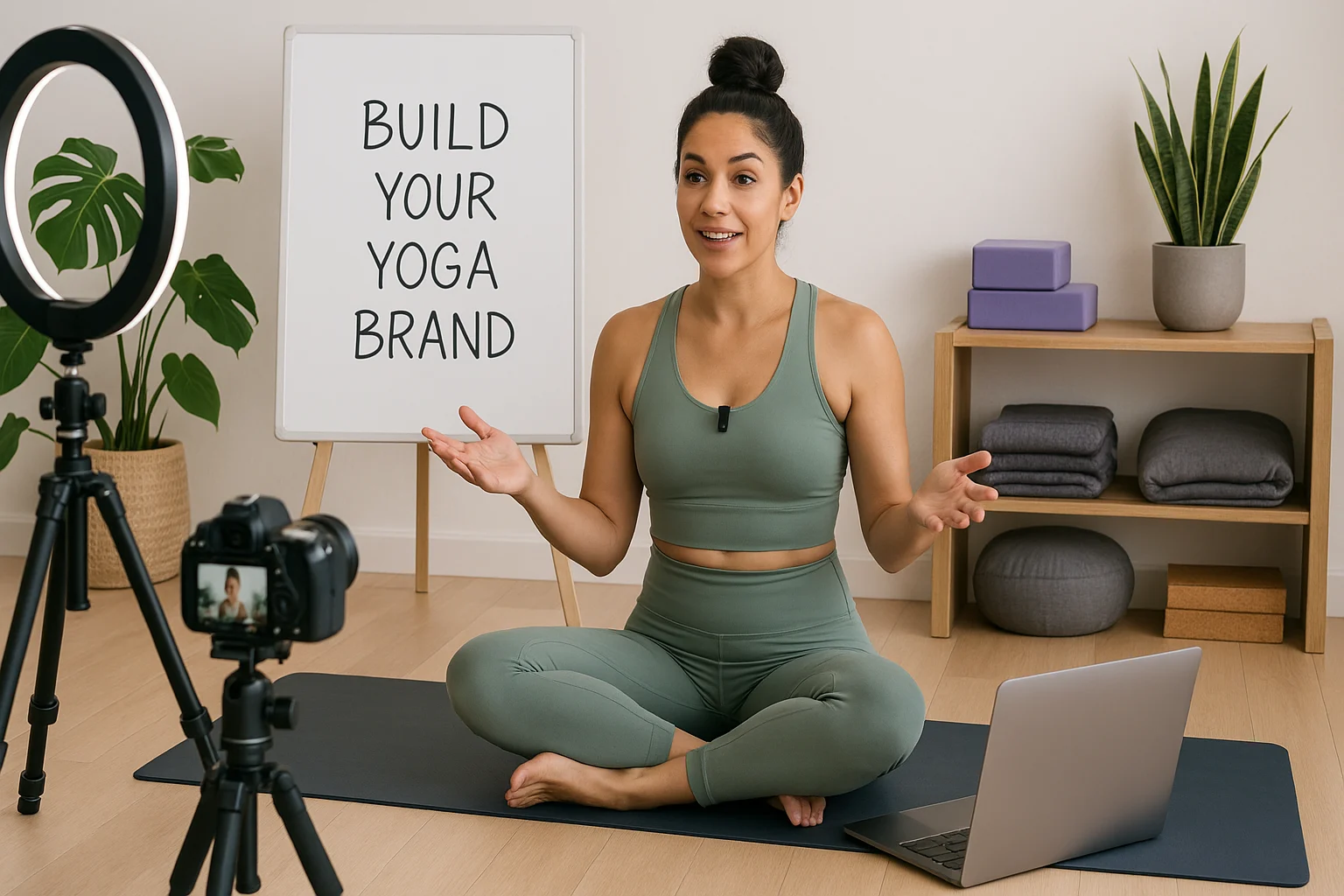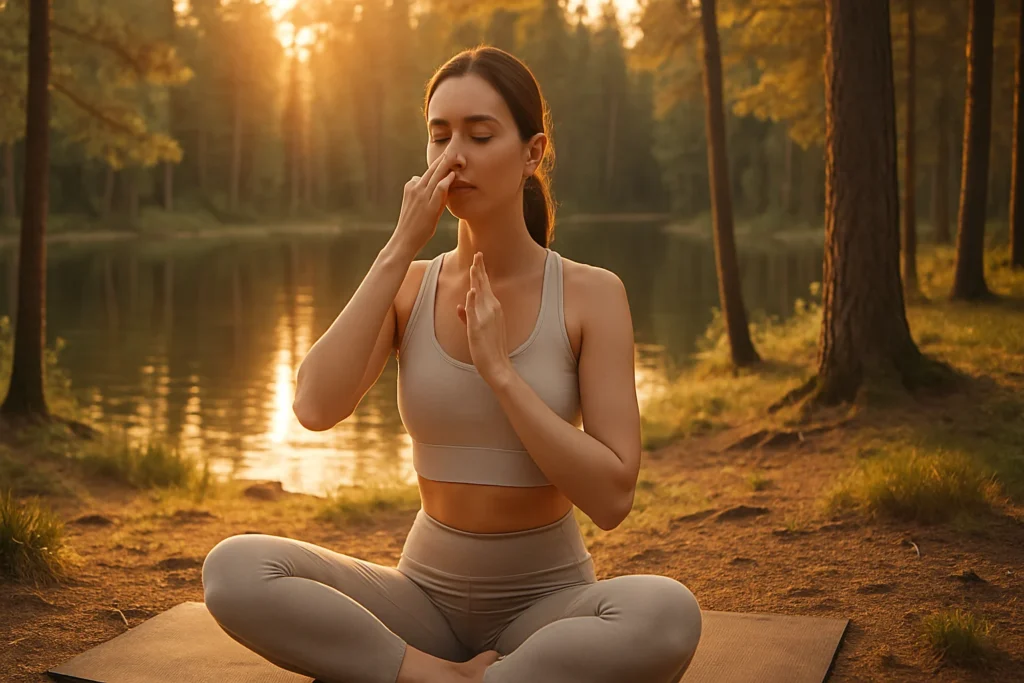
Imagine transforming your love for yoga into a career or a deeper personal practice. This yoga teacher training guide is your yoga certification roadmap to success! Whether you want to become a yoga instructor, enrich your practice, or explore the teacher training benefits, the sections below walk you through each step—from certifications to careers.
Table of Contents
- Key Takeaways from This Yoga Teacher Training Guide
- What Is Yoga Teacher Training (YTT)?
- Certification Levels: Your Path to Yoga Alliance Standards
- How to Choose the Right Yoga Training Path
- Online vs. In-Person: Format Comparison
- Best & Budget-Friendly Countries for YTT
- Teacher Path: Costs & Careers
- Business of Yoga: Marketing and Branding
- YTT Path Finder Tool
- YTT: Frequently Asked Questions
- Conclusion: Launch Your Yoga Journey Today
Key Takeaways for Your Yoga Training Journey
Mastering the yoga training essentials starts here:
- Start with the Basics: A 200-hour Yoga Teacher Training (YTT) is the foundation for most aspiring teachers, focusing on teaching essentials and personal growth.
- Certification Levels: Yoga Alliance offers RYT 200, RYT 300, and RYT 500 designations, each advancing your skills and expertise.
- Program Selection: Evaluate curriculum, instructors, format, cost, and goals to find the perfect YTT program.
- Online vs. In-Person: Online YTT provides flexibility and affordability, while in-person offers immersive, hands-on learning.
- Career Growth: Certification is just the start; continuous learning and networking are crucial for a thriving yoga career.
This post has affiliate links. We may earn a commission. Learn more.

What is a Yoga Teacher Training Guide and Its Advantages?
Yoga teacher training (YTT) is your path to becoming a yoga instructor—or simply understanding your practice. It’s more than perfecting poses. This section focuses on the essentials—philosophy, anatomy, and practical teaching skills you can apply right away. My YTT grounded me in yoga’s roots; these days each class feels like sharing something real.
Yoga Training Essentials
A solid YTT usually covers:
- Yoga Philosophy: Study the Yoga Sutras and the ethics (Yamas and Niyamas), and how they show up off the mat.
- Anatomy and Physiology: Learn how the body moves so you can teach safely and prevent injury.
- Asana Study: Understand alignment, benefits, and modifications for different students.
- Pranayama: Use breathwork to support energy and focus; it’s a powerful stress tool.
- Meditation: Help students find calm and clarity in simple, repeatable ways.
- Teaching Methodology: Build sequences, give clear cues, and create a welcoming space.
- Ethics and Lifestyle: Let values like kindness and simplicity guide life off the mat.
- Business of Yoga: Basics of marketing, finding classes, and working with studios.
“YTT isn’t just about teaching poses; it’s about embodying yoga’s principles and guiding others safely.”
Most programs align with Yoga Alliance standards, the global go-to for yoga schools (RYS) and teachers (RYT), as outlined in this yoga teacher training guide.
Who Benefits from This Yoga Teacher Training Guide?
YTT offers teacher training benefits for all sorts of folks, like:
- Personal Growth Seekers: Deepen your practice and build self-awareness.
- Health Professionals: Blend yoga into medical or therapy work for a more holistic approach.
- Community Builders: Meet other yogis and form relationships that last beyond graduation.
Want the full rundown? Explore the advantages of yoga teacher training.
Certification Levels: Your Path to Yoga Alliance Standards
Each level carries different responsibilities. Most studios look for at least RYT 200—still, local requirements vary, so it’s worth checking.
200-Hour Yoga Teacher Training (RYT 200)
The 200-hour lays the groundwork. Sarah finished her RYT 200 and now teaches part-time at about $30 per class. Many new grads find studio opportunities within their first year, depending on location and demand. It suits beginners and anyone focused on personal growth.
Curriculum (200 hours):
- Practice (100): asana, breath, meditation.
- Methodology (25): sequence, cue, adjust.
- Anatomy (20): body systems, safe alignment.
- Philosophy (30): Sutras, ethics.
- Practicum (10): teach, get feedback.
- Electives (15): business or specialty topics.
Who It’s For: Those with 6+ months of practice aiming to teach or deepen knowledge.
300-Hour Yoga Teacher Training (RYT 300)
For grads of a 200-hour YTT, the 300-hour builds depth and a specialty. Lisa used her RYT 300 to focus on trauma-informed yoga, leading workshops for veterans at around $50 per hour. Studios tend to value specialization, though demand differs by city. For details, see the 300-hour YTT guide.
Curriculum Highlights:
- Advanced asanas, pranayama, and meditation.
- Specialized teaching for seniors or athletes.
- Deeper philosophy and therapeutic applications.
Who It’s For: RYT 200 teachers seeking to specialize or lead workshops. Tip: Combine with prenatal or Yin certifications for versatility.
500-Hour Yoga Teacher Training (RYT 500)
The highest standard, achieved via 200 + 300 hours or an integrated program. John progressed to RYT 500, mentoring teachers. RYT 500 can signal expertise and may open doors to mentoring or assisting in trainings. Learn about expert-level training in the 500-hour YTT overview.
Who’s It For? Yoga teachers ready to step up and mentor others or lead advanced trainings.
Specialized Certifications
Shorter courses level up your skills and bring major teacher training benefits. Here’s a peek at some faves:
- Prenatal Yoga: A 50-hour course to guide pregnant students safely, giving you confidence to support moms-to-be.
- Yin Yoga: 30–50 hours exploring long, gentle holds that may ease stress.
- Trauma-Informed Yoga: 20–40 hours to teach with sensitivity, helping students heal through yoga.
- Restorative Yoga: 30 hours for deep relaxation. See Recovery Yoga: 10 Restorative Poses.
- Yoga for Seniors: 20–30 hours to support mobility and balance. Explore Yoga for Seniors with Back Pain.
These certifications may increase your earning potential.

How to Choose the Right Yoga Training Path
Selecting a program is key to your certification roadmap. These steps help align your choice with your goals while you build core skills.
Define Your Goals
Decide what you want to teach (Vinyasa, Restorative, etc.) and what you can spend. A little clarity up front makes every other choice easier.
Research Curriculum and Philosophy
Make sure anatomy, philosophy, and your style are actually covered. I chose a Vinyasa program with an Ayurvedic bend because it fit my goals. Check out the yoga teacher training curriculum.
Evaluate Instructors
E-RYT 500 trainers with a track record are a good sign. Read alumni reviews on Yoga Alliance or Google and verify certifications. I took a class with a potential trainer to confirm their trauma-informed approach fit me.
Consider Format and Schedule
Pick intensive (3–4 weeks), weekend modules, or online—whatever matches your calendar.
Assess Costs
Compare tuition, what’s included (books, meals), and payment options. Scholarships can bring costs down.
Check Post-Training Support
Most schools offer mentorship or job support; it’s worth confirming what that looks like. Discover top-rated yoga training programs.
Online vs. In-Person: A Yoga Teacher Training Guide Comparison
Both formats can help you become a yoga instructor. Below is a side-by-side so you can pick what fits:
In-Person Yoga Teacher Training
What people like:
- Immersive setting with real-time feedback from instructors; hands-on adjustments refined my alignment.
- Strong cohort bonds—my YTT group still checks in daily.
- Group energy can be motivating and supportive.
Trade-offs:
- Often pricier: roughly $2,000–$6,000+ depending on location.
- Significant time block—several weeks of focused training can be hard to schedule.
- Travel to remote retreats adds logistics and cost.
Online Yoga Teacher Training
What people like:
- Flexible study windows; easy to fit around a busy week.
- Lower cost for many programs ($300–$1,500).
- Learn from instructors worldwide without leaving home.
Trade-offs:
- Less in-person feedback; video submissions matter.
- Requires self-discipline over longer timelines.
- Community can feel more virtual than in-person.
Is Online Legit? Many Yoga Alliance–registered schools offer online or hybrid components; review current policies and your program’s status.
| Aspect | In-Person | Online |
|---|---|---|
| Cost | $2,000–$6,000+ | $300–$1,500 |
| Flexibility | Fixed schedule | Self-paced |
| Community | Strong | Virtual |
Best and Cheapest Countries for Yoga Teacher Training
Use this section to spot affordable, high-quality YTTs around the world, helping you become a yoga instructor while experiencing new places. From India’s low costs to Bali’s wellness focus, these destinations cover a range of budgets and styles.
India: Cheapest and Most Authentic
India, the birthplace of yoga, offers many 200-hour YTTs around $649–$1,600, among the lowest worldwide. Rishikesh is legendary, and Goa’s beaches and Mysore’s traditional scene are strong options too. When I trained in Rishikesh, mornings started with Himalayan views, temple visits, and simple vegetarian meals in an ashram. A typical day: 6 AM meditation, 7 AM asana, 10 AM philosophy. Intense, but grounding. Ashram programs lean spiritual, while modern schools offer more comfort.
Visa: requirements and fees change; check official government sources before you book.
Pack light for humid weather and expect basic but cozy accommodations.
Bali, Indonesia: Spiritual Wellness Hub
Bali’s lush landscapes make it a YTT paradise, with 200-hour programs at $2,000–$4,000, including lodging. Ubud’s spiritual core is all about temples and vegan cafes, while Canggu’s got a modern, surf-y edge. During my Bali YTT we had sunrise practice, sound-meditation sessions, and traditional bodywork—the emphasis on ritual deepened my practice.
Visa: check Indonesia’s current entry rules and fees before travel.
Skip crowded programs by reading reviews. Budget $50–$100/month for scooters or taxis. Wellness extras like acupuncture or juice cleanses are common.
Costa Rica: Popular Eco-Retreats
Costa Rica’s “Pura Vida” energy and jungles make it a YTT favorite, with programs at $1,500–$3,000. Nosara’s a wellness mecca, and Santa Teresa’s surf-yoga scene is booming. My training there mixed yoga with waterfall hikes—a memorable mix. Expect eco-retreats with solar power and organic meals. A typical cost breakdown: $1,800 tuition, $200 meals, $500 lodging.
Visa: confirm your nationality’s current entry policy and stay limits.
Nicaragua: Budget-Friendly Surf Vibe
Nicaragua’s YTTs ($1,200–$2,500) deliver affordability and beach vibes. San Juan del Sur is big, but Popoyo’s quieter scene is growing fast. I trained with ocean views, joining a community service day that taught kids yoga—so rewarding. Programs are rustic but heartfelt, with open-air shalas.
Visa: confirm current entry fees and permitted stay.
Guatemala: Hidden Gem
Lake Atitlan’s off-grid retreats offer YTTs for $1,000–$2,000, surrounded by volcanoes. San Marcos La Laguna’s spiritual vibe is perfect for meditation-heavy programs. My training included a Mayan fire ceremony that felt grounding. You’ll dive deep into mindfulness with small groups.
Visa: verify current entry policy for your passport.
Thailand: Affordable and Cultural
Thailand’s YTTs ($1,000–$2,500) blend approachable pricing with Buddhist culture. Koh Phangan’s full-moon retreats and Chiang Mai’s temple scene are standouts. My program on Koh Phangan included Thai massage skills I still use in class. Expect vegan meals, jungle shalas, and festivals like Loi Krathong for context.
Visa: confirm current entry options and fees with official sources.
Which Country Fits You? Here’s a quick comparison to help you decide:
| Country | Cost (200-Hour) | Visa | Highlight |
|---|---|---|---|
| India | $649–$1,600 | 6-month e-Tourist ($25) | Authentic ashram experience |
| Bali | $2,000–$4,000 | 30-day ($35) | Wellness culture, rituals |
| Costa Rica | $1,500–$3,000 | 180 days (free) | Eco-retreats, nature |
| Nicaragua | $1,200–$2,500 | 90-day ($10) | Beachside, community focus |
| Guatemala | $1,000–$2,000 | 90-day (free) | Meditation, Mayan culture |
| Thailand | $1,000–$2,500 | 30-day (free) or 60-day ($40) | Buddhist wisdom, festivals |
Tips: India’s the cheapest, followed by Guatemala, Thailand, Nicaragua, Costa Rica, and Bali. Check Yoga Alliance accreditation, visas, and vaccinations. For retreats, explore Yoga Retreats in Todos Santos, Mexico. Your yoga teacher training guide and certification roadmap start with the right destination—choose the place that supports your goals.

Become a Yoga Instructor: Costs, Timelines, and Career Paths
Here’s a clear look at costs and the opportunities that follow so you can plan your next step with confidence.
Costs of Yoga Teacher Training
200-Hour YTT: $300–$1,500 (online), $2,000–$6,000 (in-person).
300-Hour YTT: $1,000–$5,000+.
Additional Costs: Books ($50–$200), props, Yoga Alliance fees ($135+).
Timelines
200-Hour: 3–4 weeks (intensive), 2–9 months (modular), 1–12 months (online).
300-Hour: 3–5 weeks or 6–12 months.
Career Options
Pay varies widely by market and model (studio, private, corporate, retreats). Consider local rates and your experience when you estimate income:
- Studio teaching: lead classes at local studios ($25–$50 per class).
- Private sessions: tailored work ($50–$100 per hour). I charge about $75/hour and build repeat clients.
- Corporate yoga: on-site or virtual sessions for teams ($100–$200 per session).
- Online teaching: reach students on Zoom or YouTube. Try accessible yoga practices at home.
- Retreats: Host experiences in destination settings ($2,000–$15,000/week).
- Content creation: Monetize blogs or videos via sponsorships.
Emma built a $60,000/year online business via Instagram. Maria combines studio and online classes, earning $45,000/year. Diversify with hybrid models for stability. Protect your career with Yoga Teacher Insurance Essentials.
Business of Yoga: Marketing and Branding
Here are a few practical ways to turn your certification into a sustainable teaching practice.
Develop Your Niche
Specialize in prenatal or restorative yoga. I focused on seniors, tripling bookings. Find what makes your teaching special.
Create an Online Presence
Build a website ($100–$500/year) and use Instagram Reels or TikTok. My 15-second pose tutorials got 5,000 followers. Alex earns $2,000/month teaching online.
Leverage Platforms
Use Zoom for live classes or Patreon ($5–$20 per month per subscriber). I average about $500 per month from memberships. Partner with wellness creators whose audiences match yours.
Network and Collaborate
Partner with studios or brands. My gym collab landed corporate gigs. Hit up yoga festivals to connect.
The yoga community is sizable; thoughtful branding and diversified offerings can support sustainable income.

Your Core Yoga Training Path Finder
This yoga teacher training guide helps you answer these questions to discover your ideal path, focusing on yoga training essentials:
What’s Your Goal?
Practice Experience?
Availability?
Your Path
Please select all options to see your personalized recommendations. 💡 Tip: Try different combinations to explore all paths!
YTT: Frequently Asked Questions
Conclusion: Launch Your Yoga Journey Today
This guide maps your yoga certification roadmap, covering certifications, formats, costs, and careers. Choose the next step that fits your life, whether you want a 200-hour foundation or the RYT 500 path. Keep learning, connect with your community, and let the practice shape your way forward. Namaste.


